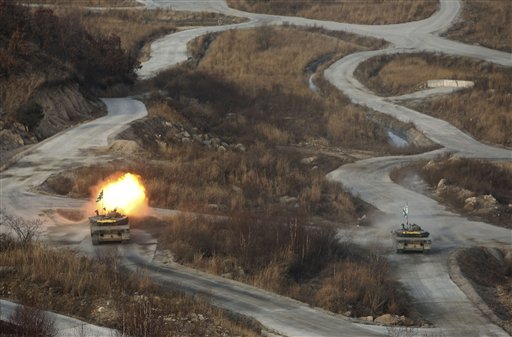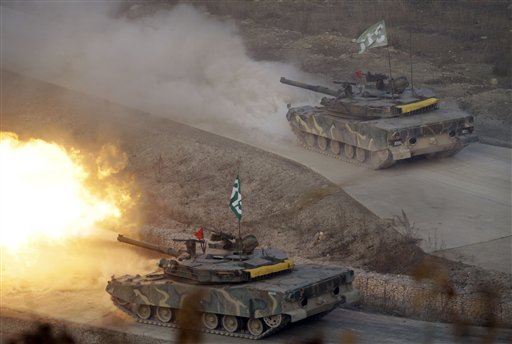 Seoul – North and South Korea beat the drums of war Thursday, with each threatening the other with immediate retaliation if attacked.
Seoul – North and South Korea beat the drums of war Thursday, with each threatening the other with immediate retaliation if attacked.
Subscribe to our Daily Roundup Email
Seoul has staged days of military drills in a show of force meant to deter North Korea, including live-fire exercises earlier this week on a front-line island shelled by the North last month. Angered by the exercises, North Korea threatened Thursday it would launch a “sacred” nuclear war if Seoul hit it and warned that even the smallest intrusion on its territory would bring a devastating response.
The two sides are still technically at war because their 1950-53 conflict ended in a truce not a peace treaty, and a U.S. governor who recently made an unofficial diplomatic mission to the North has said the situation on the peninsula is a “tinderbox” and the worst he had ever seen it.
Still, the latest rhetoric seemed likely to be just that, words aimed at stirring pride at home and keeping the rival at bay.
Defense chief Kim Yong Chun said North Korea is “fully prepared to launch a sacred war” and would use its nuclear capabilities, calling Monday’s drills a “grave military provocation” that indicated South Korea and the U.S. are plotting to invade the North.
Kim told a national meeting in Pyongyang that the North’s military will deal “more devastating physical blows” to its enemies if they cross into the North’s territory even slightly. He also threatened to “wipe out” South Korea and the U.S. if they start a war, the official Korean Central News Agency said in a dispatch.

North Korea is believed to have enough weaponized plutonium for at least a half-dozen atomic bombs. Secretary of State Hillary Rodham Clinton said in April that the United States knows that the North has “somewhere between one and six nuclear weapons.”
While Kim’s remarks mentioned South Korea’s military drills, it’s more telling that they come on the eve of the 19th anniversary of leader Kim Jong Il’s appointment as the supreme military commander — a day when Pyongyang will want to rev up patriotic spirit.
Earlier Thursday, South Korea’s president vowed a strong response if North Korea attacks again as his military conducted its largest air-and-ground firing drills of the year at training grounds near the tense Korean border.
“I had thought that we could safeguard peace if we had patience, but that wasn’t the case,” President Lee Myung-bak said during a visit to a front-line army base near the Koreas’ eastern land border, according to his office. “Our military must … make unsparing response if it suffers surprise attacks.”
Near the Koreas’ land border, South Korean tanks fired artillery and fighter jets zoomed by to drop bombs Thursday, signaling South Korea’s determination to demonstrate and hone its military strength at the risk of further escalation with North Korea.
The boom of cannons echoed through the valley, and the hills erupted in smoke at training grounds in mountainous Pocheon about 20 miles (30 kilometers) from the border. Rockets streamed through the air and slammed into the side of a hill as helicopters overhead fired at targets and F-15 jet fighters dropped bombs.

The drills were the armed forces’ largest joint firing exercises this year and the biggest-ever wintertime air and ground firing exercises in terms of the number of weapons mobilized and fired, government and army officials said.
New Mexico Gov. Bill Richardson warned in an interview Wednesday that violence could flare anew between the two rivals if the South continues its drills and the North abandons its stated intention of refraining from retaliation.
Exactly one month ago, routine South Korean live-fire drills from Yeonpyeong Island in the Yellow Sea triggered a shower of North Korean artillery that killed two marines and two construction workers. It was the first military attack on a civilian area since the Korean War.
North Korea, which claims the waters around the South Korean-held island lying just seven miles (11 kilometers) from its shores as its territory, accused the South of provoking the exchange by ignoring Pyongyang’s warnings against staging the live-fire drills near their disputed maritime border.
China — North Korea’s only major ally — called again for restraint on Thursday.
“The current situation remains highly complicated and sensitive,” Chinese Foreign Ministry spokeswoman Jiang Yu told a regular briefing. “We appeal to the relevant parties to keep calm, exercise restraint, and adopt responsible attitudes and do more to ease the situation and safeguard peace and stability on the peninsula,”
The military tension over the past month has soared, and comes on the heels of the March sinking of a South Korean warship that a Seoul-led international investigation blamed on Pyongyang, but which North Korea denies. Forty-six sailors died.

I love when they say we will WIPE OUT south korea and the u.s. North korea you better watch out!!
The war of gog and magog is fastly approaching.
time fro the south to stop talking and reacting the north knows they are all talk they sunk a ship no reaction they shelled and killed people in the south and no response
#4 sounds like kefira too me stop watching movies and become normal
They’re just doing the required dance.
Lots of posturing.
Lots of threats of retaliation if anyone does anything.
Lots of scary drills.
Lots of chest thumping.
What they’re not doing is fighting. Gives me some hope that they’ll settle down once China privately tells Dear Leader to stop being crazy.
Speaking of crazy, Poster #6 , are you willing to sign over all your possessions to me in a legally binding contract that takes effect on 12-24-12? I could use some cheer on Nittel Nacht. If not, be quiet.
If North and South Korea ultimately go to war, we should stay out of the fight. South Korea can fight its own battles. We already lost over 40,000 of our sons in a no-win war from 1950-1953, plus another unknown war, called The DMZ war from 1966-1968, plus the capture of the USS Pueblo (which N. Korea still possesses), plus the shooting down, by North Korea, of a U.S. unarmed reconnaisance plane in international waters, in 1969.